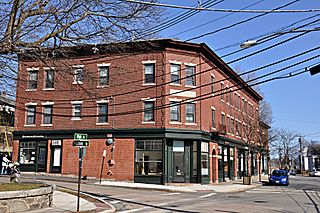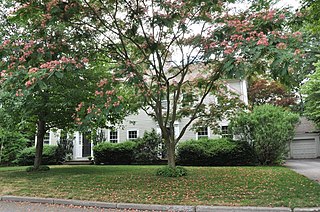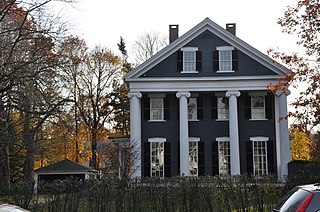
Chestnut Hill is a wealthy New England village located six miles (10 km) west of downtown Boston, Massachusetts, United States. It is best known for being home to Boston College and a section of the Boston Marathon route. Like all Massachusetts villages, Chestnut Hill is not an incorporated municipal entity. It is located partially in Brookline in Norfolk County; partially in the city of Boston in Suffolk County, and partially in the city of Newton in Middlesex County. Chestnut Hill's borders are defined by the 02467 ZIP Code. The name refers to several small hills that overlook the 135-acre Chestnut Hill Reservoir rather than one particular hill.

The John Adams Birthplace is a historic house at 133 Franklin Street in Quincy, Massachusetts. It is the saltbox home in which Founding Father and second president of the United States, John Adams, was born in 1735. The house was designated a National Historic Landmark in 1960, and is listed on the National Register of Historic Places. It is now administered by the National Park Service as part of the Adams National Historical Park, and is open for guided tours.

Newton Upper Falls is one of the thirteen villages within the city of Newton in Massachusetts, United States. The village is listed as the Newton Upper Falls Historic District on the National Register of Historic Places.

Waban is one of the thirteen villages within the city of Newton in Middlesex County, Massachusetts, United States.

The Boardman House, also known as the Scotch-Boardman House or the Bennett-Boardman House, is a historic house located at 17 Howard Street, Saugus, Massachusetts. Built in 1692, it was designated a National Historic Landmark in 1961 because of the remarkable amount of original building material still present in the house. It has been owned by Historic New England since 1914, and is open to the public on select weekends between June and October.
Oak Hill Park (OHP) is a residential subdivision located in the Oak Hill village of Newton, Middlesex County, Massachusetts. Oak Hill Park is shown as a separate and distinct village on some city maps, including a map dated 2012 on the official City of Newton website. Situated adjacent to Boston (West Roxbury), Oak Hill Park is roughly bounded by Mount Ida College to its northwest, Dedham Street to the northeast, the Charles River to the southwest, and Mount Lebanon Cemetery and the Boston city limit to the southeast.

The following properties in Newton, Massachusetts are listed on the National Register of Historic Places. They are a subset of all properties in Middlesex County. There are over 180 places listed in Newton.

The Bartlett–Hawkes Farm is a historic house at 15 Winnetaska Road, in the Waban village of Newton, Massachusetts. With its oldest portion dating to about 1736, it is the oldest surviving building in Waban. Enlarged several times, it was moved to its present location from Beacon Street in 1915. It was listed in the National Register of Historic Places on September 4, 1986.
East Parish Burying Ground, also known as Centre Street Burying Ground or Centre Street Cemetery, is an historic cemetery located at Centre and Cotton streets in the village of Newton Corner in the city of Newton, Massachusetts. On December 23, 1983, it was listed on the National Register of Historic Places. It has been called the "most important, the most evocative and also the most fragile historic site in the city."

Craftsman Farms is a historic house located in Parsippany-Troy Hills, Morris County, New Jersey, United States. It was founded by noted early 20th century designer Gustav Stickley as a farm and school for the Arts and Crafts movement. It remained in use until 1915 when it was sold to a family and became a private house.

The Sudbury Aqueduct is an aqueduct in Massachusetts. It runs for 16 miles (26 km) from Farm Pond at Waverly Street in Framingham to Chestnut Hill Reservoir in Boston’s Chestnut Hill neighborhood. A later built extension main runs from the Farm Pond gatehouse to the gatehouse at the Stearns Reservoir where additional mains connect to the Brackett and Foss Reservoirs Going east from Framingham, it runs through Sherborn before entering Natick. From Natick it runs east through Wellesley and Needham to the Charles River, which it crosses on the Echo Bridge into Newton. It ends at the Chestnut Hill Reservoir on the Newton side of the Newton-Boston line. The Massachusetts Water Resources Authority (MWRA) operates the aqueduct.

The Curtis—Shipley Farmstead is a historic home located at Ellicott City, Howard County, Maryland, United States. It is located on the first land grant in modern Howard County, then Anne Arundel County, to the English settler Adam Shipley in 1688 who settled properties in Maryland as early as 1675. The 500-acre estate was called "Adam the First".

The Charles Newton House is a historic house at 24 Brattle Street in Worcester, Massachusetts.

The Frederick Collins House is a historic house at 1734 Beacon Street in Newton, Massachusetts. The 2+1⁄2-story wood-frame house was built in 1847, and is the only temple-front Greek Revival house in the village of Waban. It as two-story Ionic columns supporting an entablature and triangular pediment. The tympanum is flushboarded, an attempt to give it the appearance of ashlar stone. Side entrance are also set under Ionic porches, and the building has corner pilasters.

The Pine Ridge Road–Plainfield Street Historic District encompasses a residential subdivision in the Waban section of Newton, Massachusetts. It includes 44 properties on Pine Ridge Road and Plainfield Street between Chestnut Street and Upland Road, and includes a few properties on the latter two streets. The area was laid out for development in the 1880s after the arrival of suburban rail service, and was built out by the 1930s. The district was listed on the National Register of Historic Places in 1990.
Thomas Wiswall (1601–1683) was an early settler of British America, a prominent early citizen of the Massachusetts Bay Colony, and a key figure in the founding of Cambridge Village, now known as the city of Newton, Massachusetts.

The Carl E. and Alice Candler Schmidt House is a private home located at 301 Lake Shore Rd. in Grosse Pointe Farms, Michigan. It was listed on the National Register of Historic Places in 2005. Built in 1904, the house is one of the oldest remaining properties in the Grosse Pointes to have a view of Lake Saint Clair.

The Benjamin Thayer House is a historic house at 200 Farm Street in Blackstone, Massachusetts. Built around 1790, it is the best-preserved property associated with the Thayer family, who were prominent landowners and one of the first Pilgrim families. Benjamin Thayer and his descendants lived and farmed here until about 1920, when the property, much reduced in size, was sold out of the family. The house and its surrounding 9 acres (3.6 ha) of surviving farmland was listed on the National Register of Historic Places in 2009.

The Oliver House, also known as the Smith-Oliver House, is a historic house at 58 Oak Street in Wakefield, Massachusetts. Probably built in the late 18th century, this Federal period house is distinctive for its association with the now-suburban area's agrarian past, and as a two-family residence of the period, with two "Beverly jogs". The house was listed on the National Register of Historic Places in 2014.

West-Harris House, also known as Ambassador House, is a historic home located at 106th Street and Eller Road in Fishers, Hamilton County, Indiana, United States. The ell-shaped, two-story, Colonial Revival-style dwelling with a large attic and a central chimney also features a full-width, hip-roofed front porch and large Palladian windows on the gable ends of the home. It also includes portions of the original log cabin dating from ca. 1826, which was later enlarged and remodeled. In 1996 the home was moved to protect it from demolition about 3 miles (4.8 km) from its original site to its present-day location at Heritage Park at White River in Fishers. The former residence was listed on the National Register of Historic Places in 1999 and is operated as a local history museum, community events center, and private rental facility.



















